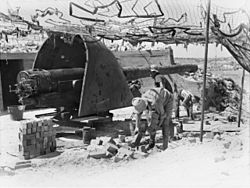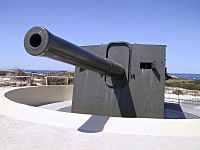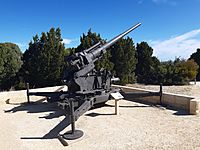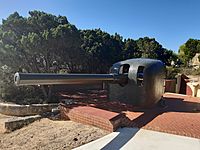Leighton Battery facts for kids
Quick facts for kids Leighton Battery |
|
|---|---|
| Buckland Hill, Mosman Park, Western Australia in Australia | |

Construction of No. 2 gun position, Leighton Battery, February 1943
|
|
| Coordinates | 32°01′04″S 115°45′24″E / 32.01778°S 115.75667°E |
| Site information | |
| Owner | Minister for Defence |
| Operator | Australian Army |
| Open to the public |
Above-ground installation freely accessible Underground installation open on the first Sunday of every month |
| Condition | Now the Leighton Battery Heritage Site operated by the Royal Australian Artillery Historical Society of Western Australia |
| Site history | |
| Built | 1941 |
| Built by | 7th Troop of the Royal Australian Engineers Royal Australian Artillery Public Works Department of Western Australia |
| In use | 1941−1963 |
| Events | Part of the Fremantle Fortress during World War II |
Leighton Battery is a historic military site in Mosman Park, Western Australia. During World War II, it was a key part of Australia's coastal defenses. It helped protect Fremantle Harbour from enemy attacks.
The battery first had two large 6-inch naval guns. These guns started working in February 1943. In 1945, these guns were replaced by three newer 5.25-inch guns. These new guns could be used both against ships and against aircraft. Leighton Battery was the only place in Australia where these special dual-purpose guns were actually used. The battery was taken apart in 1963. Its equipment was sold for scrap metal.
The site of the battery was added to the Western Australian State Register of Heritage Places in 1999. It also received a special award for its engineering history in 2014. Some parts of the battery above ground have been fixed up. The underground tunnels and rooms are still there. They show amazing engineering work from that time.
Contents
Protecting Fremantle: The Fortress Story
In the mid-1930s, the Australian Government started to improve its coastal defenses. The goal was to protect major ports from enemy attacks. Protecting Fremantle Harbour in Western Australia was very important. This was done by making existing batteries better and building new ones.
Batteries at places like Leighton, Swanbourne, and Rottnest Island were improved. New batteries were also planned for Garden Island and Rottnest Island. All these defenses together were called the Fremantle Fortress.
At first, large 9.2-inch guns were planned for Buckland Hill. But this was not enough to stop enemy ships with powerful 8-inch guns. So, the 9.2-inch guns were placed on Rottnest Island instead. This was part of the Oliver Hill battery. These guns could fire up to 28 kilometers. This allowed them to hit enemy ships before they got close enough to attack Fremantle Port. Protecting Fremantle Port was vital for Australia's safety during the war.
Other batteries were also set up with 6-inch guns. These were on Rottnest Island (Bickley Battery), Arthur Head, and Fort Forrest. The Fort Forrest guns were moved to Swanbourne in 1935. Buckland Hill was not chosen then because it was too close to other important buildings. When World War II began, the batteries on Rottnest Island, Arthur Head, and Swanbourne were ready for action.
Leighton Battery: Its Role and Guns
In 1941, Buckland Hill was chosen for four 3.7-inch anti-aircraft guns. These guns were ready later that year.
By early 1942, the guns at Arthur Head battery had a problem. They had to fire over many ships anchored in Gage Roads. There were many more ships there since the war started. So, in mid-1942, it was decided to move the Arthur Head battery to Buckland Hill. This new site became Leighton Battery.
In early 1943, two 6-inch guns were moved from Arthur Head to Leighton. They were tested on February 8, 1943. The construction of Leighton Battery was a team effort. The 7th Troop of the Royal Australian Engineers, the Royal Australian Artillery, and the Public Works Department of Western Australia all helped. Many women from the Australian Women's Army Service also worked on the battery.
After the Fall of Singapore in February 1942, Fremantle became even more important. It became the biggest submarine base in the Southern Hemisphere.
Leighton Battery's job was to be an "Examination Battery." This meant it had to identify incoming ships before they entered Fremantle Port. The 6-inch guns were used until March 1945. Then, they were moved to the Princess Royal Fortress in Albany.
Even while the Arthur Head battery was being moved, plans were made to replace older guns with new 5.25-inch guns. These new guns could fight both ships and aircraft. In 1944, it was decided to put these guns at Leighton, South Fremantle, and Point Peron. Work started at Leighton in May 1945. But money problems meant it wasn't finished until late 1947. The guns were tested in November that year. The new guns were never fully installed at South Fremantle or Point Peron. So, Leighton Battery became the only place in Australia where these dual-purpose 5.25-inch guns were used. Eight such batteries were planned across Australia.
After the war, the battery was used for training by the army. From 1952, it was also used by the Citizens’ Military Force. The battery stopped being used in 1963. The entrances to its tunnels were then closed.
Besides the parts above ground, the battery had a large underground area. This area is still there today. It has many tunnels, an observation post, rooms for ammunition, engines, and resting. There was also a command post partly buried underground. The tunnels were dug 10 meters deep and were over 300 meters long.
The battery also used Bofors 40 mm guns. At its busiest time, Leighton Battery had up to 135 men and women working there.
Leighton Battery was never fired at an enemy target. It was only ever used for practice and training.
After the Military: A Heritage Site
In 1984, the Australian Government gave the Buckland Hill site to the Town of Mosman Park. Most of the area was redeveloped. Other parts became a public park. The area where Leighton Battery stood was given to the Royal Australian Artillery Historical Society of Western Australia. They wanted to create a museum there.
During the 1980s and 1990s, the site was restored. It officially opened on November 29, 1997. Major General Michael Jeffery, who was the Governor of Western Australia, opened it.
In 2014, a special gun shield was found. It had been removed from the HMAS Adelaide warship in 1943 and dumped in a rubbish tip. A member of the Royal Australian Artillery Historical Society of Western Australia found it. They had been looking for such a shield for 20 years. It was a perfect match for a 6-inch naval gun they had from HMAS Sydney. This gun was from a ship that was scrapped in 1929. The shield was brought to Perth and fixed up. In September 2015, the naval gun and shield were put at Leighton Battery. They now look like the original 6-inch guns that were once there.
Protecting History: Heritage Listings
The Leighton Battery site was listed on the now-closed Register of the National Estate in 1993. It received a National Trust Classification in 1996. It was then declared a State Register of Heritage Place in 1999. In 2014, the site was given an Engineering Heritage National Marker by Engineers Australia.
Other batteries of the Fremantle Fortress are also listed as State Heritage sites. These include the Bickley and Oliver Hill Batteries on Rottnest Island. The Cape Peron K Battery is also listed.
Images for kids





